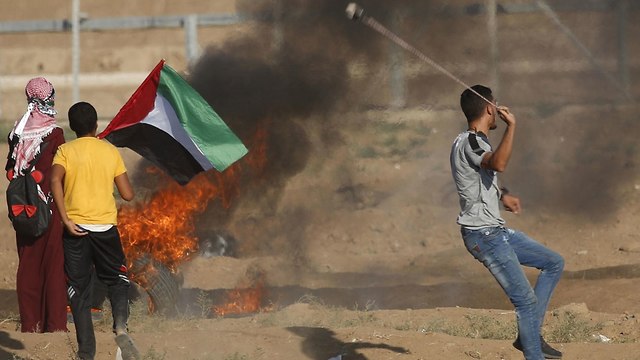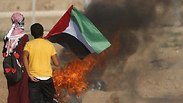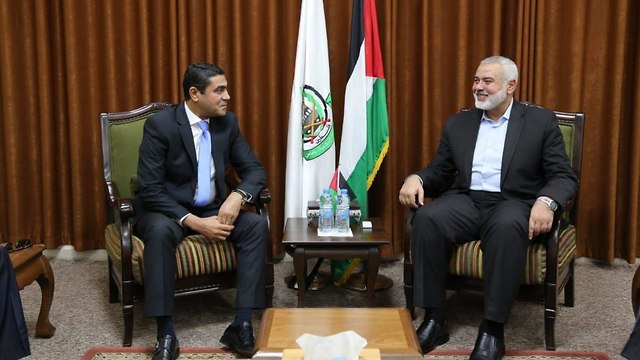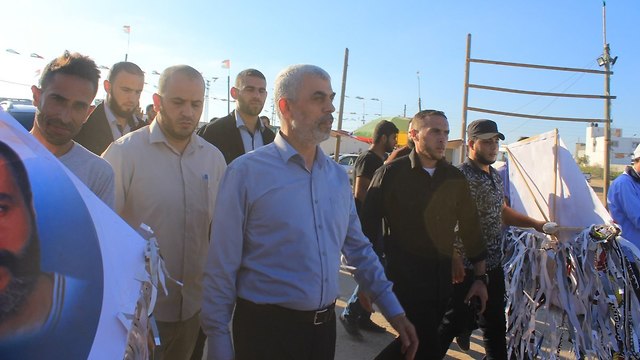
Hamas's 'wait and see' strategy in Gaza ceasefire talks
Analysis: The terror group is curbing the violence on the border until it becomes clear what it can get from Israel and the PA. With Israel on the verge of calling early elections, Hamas knows it can get whatever it wants, including a seaport. Meanwhile, everything Israel does on the border lacks real direction, while the government makes populistic decisions, which might cause a flare-up in the West Bank and Gaza.
"Tahfif" in Arabic stems from the word "hafif," which is an expression well known to Israelis, even those who don't speak Arabic, and describes a shoddy manner of doing things. And between us, everything Israel does on the border is shoddy and lacks real direction. "Arrangement" is a word that was invented to dodge the term "agreement."
Hamas was the one that decided to lower the flames, as the Gaza rulers estimate they are on the verge of reaching an Egypt-mediated agreement with Israel, like the agreement achieved after the 2014 Operation Protective Edge, when Israel opened the Gaza border crossings, the strip's fishing zone was increased to nine nautical miles, and international commitments were made to rehabilitate the coastal enclave.
This time, allowing fuel into the strip was added, and by doing so Israel is allowing Gaza's residents to enjoy a supply of electricity for more than eight hours per day.
Furthermore, this is the first time Israel has made a move vis-à-vis Hamas, while bypassing and weakening the Palestinian Authority (PA) by pressuring it not to tighten the sanctions imposed on Gaza, as well as circumventing Palestinian President Mahmoud Abbas on the strip's fuel supply.
In addition, negotiations to transfer Qatari money into the strip are currently ongoing—despite the PA's objection—to pay the salaries of Hamas officials.
If Egyptian President Abdel Fattah al-Sisi succeeds in convincing Abbas to allow the transferring of funds into Gaza, Hamas could dub its violent strategy over the past eight months as a success, and move on to the "tahfif" strategy—continue the "March of Return" protests, but cease to create provocations on the border and halt the launching of incendiary balloons.
Meanwhile it is unknown whether an agreement has been reached with the PA regarding the Qatari funds, as that would require Hamas to meet a series of conditions imposed by Abbas, which include giving up its independent military force.
But this is not the only obstacle to achieving calm: Israel's defense establishment knows that receiving fuel and Qatari money will not be enough for Hamas to halt the violence.
The terror organization has another card up its sleeve, which it plans to reveal once it receives the money from Qatar—a demand for a seaport independent of any Israeli involvement.
For Hamas, the seaport would be the ultimate achievement, justifying the hundreds of dead and wounded Palestinians in the "March of Return" campaign.
The seaport symbolizes the lifting of the siege, and building it is not so far-fetched. Defense Minister Avigdor Lieberman and Transportation Minister Yisrael Katz have both spoken in past about establishing a seaport in Gaza under Israeli supervision. As far as Hamas is concerned, it is already half way there; only one tiny condition is yet to be fulfilled—a seaport independent of Israel.
Hamas thinks that with a little pressure applied on the Israeli government, whose sole interest is its own survival, it can achieve its goals.
Moreover, the IDF has advised the political echelon not to go to war in Gaza now, and rejected Lieberman's plan to deliver a hard blow to Hamas, fearing it would escalate into a ground operation in the strip. Nevertheless, the army is also convinced several rounds of limited fighting are yet to come. And what then? Nobody knows.
So what should Hamas understand from all of this? That it can demand more, since it is not under a real existential threat. Give them a finger, and they'll take the whole hand.
Hamas leader in Gaza Yahya Sinwar and his close circle know the Israeli society very well. They know that when the Israelis living in Gaza border communities say they are at their wit's end, the government, with elections on the horizon, can be brought down to its knees—meaning they can continue applying pressure. After a seaport, Hamas might demand an airport.
Israel's own "hafif" strategy creates a situation in which the left hand doesn't know what the right hand is doing. On the one hand, Israel is making an effort to achieve calm, while on the other hand two decisions that will certainly cause a flare-up in security prisons in Israel—and as a result in the West Bank and Gaza—have been made.
A law allowing Israel to deduct money the PA is transferring to families of security prisoners, alongside an instruction not to allow the prisoners to receive the PA's NIS 400 monthly allowance for food and clothing, will go into effect in the beginning of January.
If the PA doesn't pay, Israel would pay tens of millions of shekels. But that's not the point. The security prisoners, who are allowed certain independence in their daily life, would no longer be afforded that. And when the prisons go up in flames, so do the territories. This is a populistic decision. Who needs it?




















